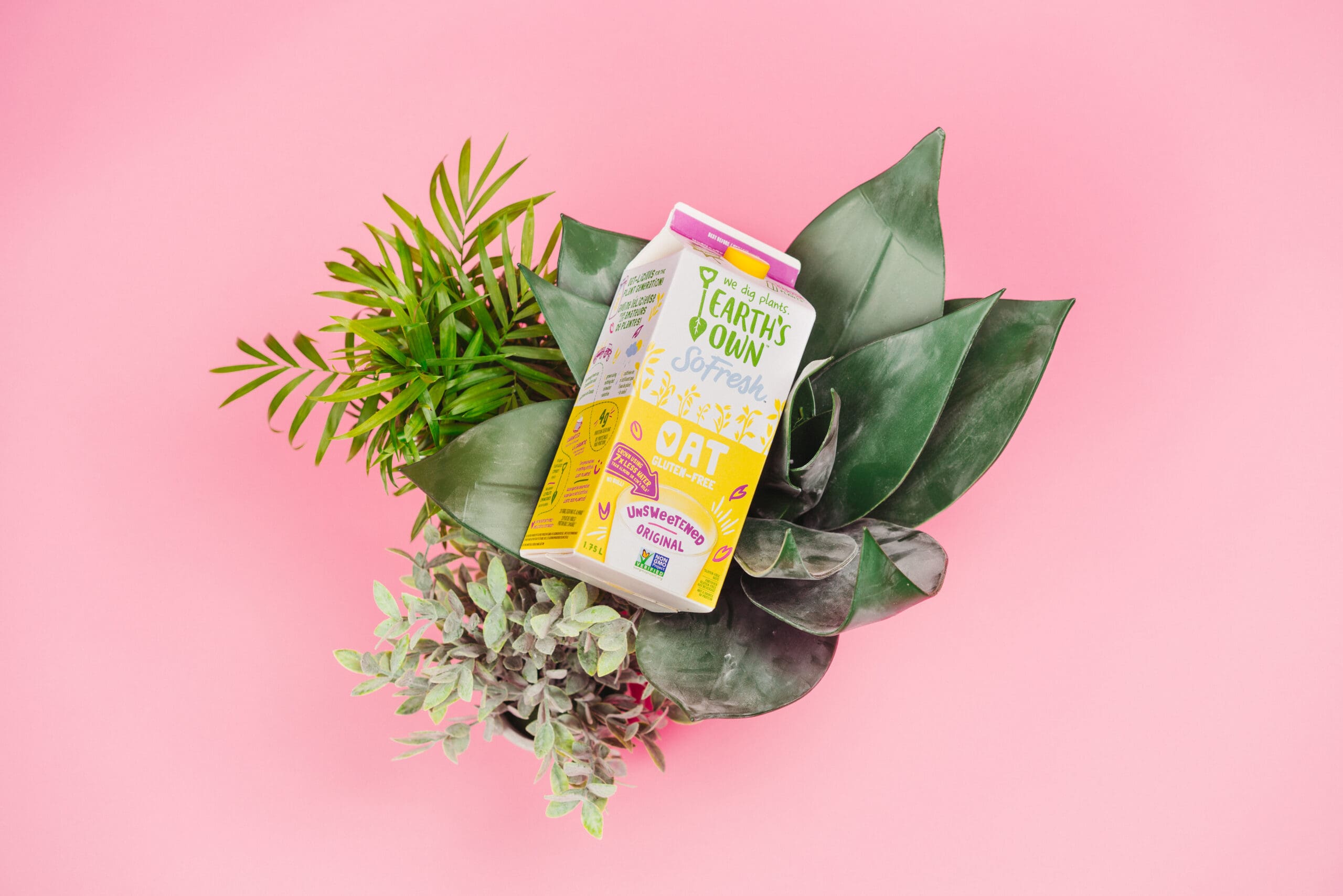Here’s an Earth Day new flash! Did you know that the single biggest thing you can do to protect our planet has nothing to do with the three Rs or using less plastic? Turns out, it’s all about what’s on your plate. If everyone shifted to a plant-based diet, we could feed the world with a 50 per cent smaller carbon footprint, 75 per cent less land use and 20 per cent less water use. Those are some pretty staggering numbers! In that environmental vein, our friends at Earth’s Own are asking Canadians to take The Plant Challenge and commit to eating plant-based on Earth Day, and they’ve partnered with cookbook author Samantha Turnbull to help us do so. —Vita Daily

Hi Samantha! Please tell us a bit about yourself to start.
I’m the last person in the world I thought would go vegan. I grew up in a family of foodies, chefs, butchers and hunters. I love meat and cheese, and I thought I would be that way forever. But in 2012 I watched a documentary that opened my eyes, and I made the decision to go vegan overnight! At first I thought all vegan food had to be filled with kale and quinoa, and required hard-to-find, expensive ingredients. That’s fine for some, but for me it didn’t satisfy my cravings. So instead, I got inspired by my old favourite recipes, and began looking for easy (and delicious) ways to sub out the animal products. I started sharing my recipes online, and my new passion for vegan recipe writing began.
Most people would (still) be surprised to learn that the single biggest thing one can do to protect the planet and help fight climate change is to reconsider our diets and eat plant-based. How exactly/in what tangible ways can going plant-based benefit the environment?
It’s true! When people think about making choices with the planet in mind, they decide to take the bus instead of driving, recycle more, or try and use less plastic; but the reality is the single biggest thing you can do as an individual to fight climate change is to eat plant-based. How easy is that? In fact, my favourite Canadian plant-based milk brand, Earth’s Own, recently commissioned a survey that revealed only 4 per cent of Canadians actually know that reconsidering what’s on your plate is the most significant way we can help save the planet.
To celebrate Earth Day, Earth’s Own—the Canadian plant-based milk company—has launched #ThePlantChallenge, encouraging Canadians to eat plant-based for the planet on Earth Day; how do you suggest we take part in this challenge?
Yes! I love this initiative so much. This Earth Day, Earth’s Own is asking all Canadians to mark the occasion by doing the single biggest thing we can do to save our planet: eat plant-based. Participating is easy! Step 1: Choose plant-based foods for all of your meals on April 22. Step 2: Inspire others to join the journey by publicly sharing your participation in The Plant Challenge online—share the Earth’s Own announcement post found on @earthsowncanada, use the hashtag #theplantchallenge and tag up to five friends. For every share, 25 cents (up to $25,000) will be donated to the Earth’s Own Plant Project, a fund dedicated to supporting groups and organizations working to fight climate change by sparking a shift to plant-based eating.
What does plant-based eating mean? How did your own plant-based journey begin, and how is it going/how has it evolved?
To me, plant-based eating really just means choosing the plant-based option over an animal product. You can go the healthy route and enjoy crunchy salads and fresh fruit, or you can go the junk food route and dive into hearty vegan cheeseburgers and decadent chocolate cake. Either way that makes you happy is the perfect way to be plant-based in my opinion. Personally, I’m somewhere in the middle, I love both healthy plant-based meals and vegan junk food! I was first inspired to go plant-based after watching a documentary called Vegucated. I then dove into every documentary and book about the environment, health, and animal cruelty I could get my hands on. What I realized is that if I wanted to live my life according to my own values, I had to go vegan. Once I had a few go-to plant-based meals on rotation it really became just as easy to eat this way as any other way. The main difference is that I now know I am doing better for myself and the environment every day by digging into a bowl of tofu bolognese, or noshing on jackfruit tacos. How fun is that? My only regret is that I didn’t go vegan sooner!
What are some common barriers to going plant-based? Any personal tips to overcome them?
I get it that people are nervous about going plant-based. I felt the same way when I decided to make the switch almost nine years ago. But going plant-based can be as easy as it is delicious. My suggestion is to start small, making simple switches and be easy on yourself! You probably won’t be perfectly plant-based on day 1 and that is OK! I asked my followers for some of their top concerns about going plant-based—and here are some of their top struggles and my recommendations on how to break down some of the barriers people face:
- barrier: will I get enough protein? The easy answer is YES! This is a widespread misconception. All whole plant foods contain protein, and as long as you eat a variety of whole plant foods, you will easily get all the protein you need. For example, one of my favourite quick and easy protein-packed meals is Vegan Tofu Taco Crumbles. The tofu is seasoned with spices and then dried in the oven. This makes the tofu have a meaty chewy texture that is amazing. Load up a taco with your favourite toppings for an easy scrumptious meal.
- barrier: for most people, there is one food that they can’t picture living without. For some, it’s a burger; for others, it’s cheese, but the one I hear most often, is coffee. The good news is that these days there are plant-based alternatives to all your favourite foods. I couldn’t imagine starting my day without coffee, so I always make sure to have Earth’s Own Oat Barista on hand. It has a creamy taste and texture, and with a dollop of agave, it’s the perfect way to start my morning.
- barrier: how to feed families or picky-eaters. The truth is that eating plant-based doesn’t have to be light years different than the way you’re already eating now. The easiest way to transition to a plant-based diet is to sub your favourite meals with the plant-based version. So if your kids (or yourself) love mac & cheese, pizza and cookies—you can still eat all of those things, just swap for a plant-based version! Even if your goal is to incorporate many more vegetables into your diet, don’t feel the need to go from a meat-based diet to eating nothing but smoothies and grain bowls. Make a slow transition, and you will find it a lot more sustainable and enjoyable.
- barrier: interestingly, one of the most significant barriers to going plant-based isn’t food at all; it’s worrying what other people will think. It’s funny, because if you feast on fast food, no one blinks an eye but tell people you want to eat more plants, and suddenly everyone is concerned about your nutrition. Instead of getting into an argument, try just speaking about why it’s important to you and how it makes you feel. It’s hard to argue with the idea of choosing plant-based to save the planet!
If you could only eat one plant-based meal or dish for the rest of your life, what would it be? (And, any chance we could get the recipe?!)
Yes! I love pasta, always have and always will. This creamy pesto pasta is easy to make:
Creamy Vegan Pesto Penne
Prep Time 5 mins
Cook Time 15 mins
Total Time 20 mins
Servings: 4 – 6
Pasta Ingredients:
1 pound penne pasta or other short pasta (gluten-free if preferred)
¾ cup sun-dried tomatoes, sliced (optional but super yummy!)
Creamy Vegan Pesto Ingredients:
2 cups fresh basil (40g)
1 cup Earth’s Own Oat Culinary
6 tablespoons nutritional yeast
3 cloves garlic, peeled
¾ teaspoon salt (or to taste)
¼ teaspoon black pepper
Bring a large pot of water to a boil and cook the pasta according to the package directions. In the meantime, make the pesto cream. To a blender add the basil, Earth’s Own Culinary Edition Oat cream, nutritional yeast, garlic, salt, and pepper to a blender and blend until smooth. Once the pasta is cooked, drain and return to the pot. Pour over the pesto cream and add the sun-dried tomatoes. Mix well. Serve hot. Notes: For the basil, don’t waste the stems. Basil stems are edible and packed with flavour just like the leaves. So when making the pesto cream I add the leaves and stems to the blender. For the sun-dried tomatoes, these are optional, but I love the salty chew they add to this dish. You can use the sun-dried tomatoes that are packed in oil or sun-dried tomatoes not in oil.

Be the first to comment